Have you ever seen someone stand on one leg without moving? It’s amazing, right? They seem to have a secret. But it’s really about their connection with a key yoga pose.
Tree Pose, or Vrksasana in Sanskrit, is all about balancing on one leg. It’s named after a tree because it makes you feel strong and flexible like one. It’s a way to connect with nature’s power.
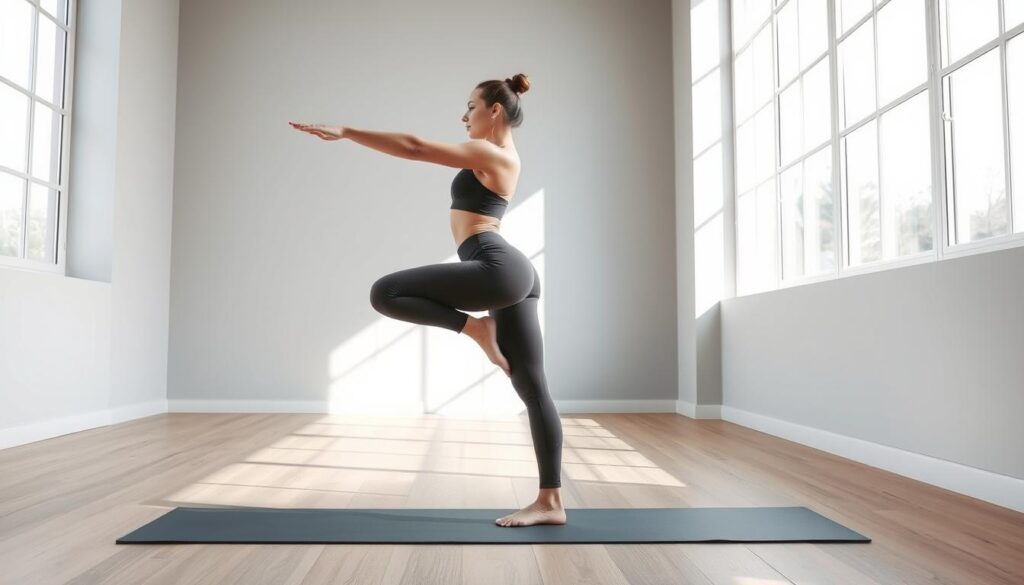
This pose is easy to start with, no matter if you’re new or have been practicing for years. It helps you stand steady and focus your mind. It’s a great way to improve your balance and concentration.
Tree Pose is simple yet powerful. It makes your core stronger, helps you focus, and connects your body and mind. It’s a basic yet essential part of yoga.
Key Takeaways
- Tree Pose (Vrksasana) is an accessible standing balance posture suitable for all skill levels
- The Sanskrit name means “tree,” reflecting the pose’s emphasis on grounded stability and graceful strength
- Regular practice improves physical balance, core strength, and mental concentration
- This fundamental posture serves as an excellent entry point for developing a mind-body connection
- The pose challenges practitioners to find stability while standing on one leg
- Benefits include enhanced focus, improved posture, and increased body awareness
Understanding Yoga Tree Pose (Vrksasana) and Its Sanskrit Meaning
Tree Pose, or Vrksasana, has deep roots in Sanskrit and yoga philosophy. It’s more than a physical exercise; it’s a bridge to spiritual growth. This pose connects us to ancient wisdom through its symbolism and spiritual depth.
Tree Pose is not just a physical exercise. It’s a journey to find balance between the earth and our inner selves. It teaches us to be strong and focused, just like a tree.
What Vrksasana Means in Sanskrit
Vrksasana in Sanskrit breaks down into two parts. “Vrksa” means “tree,” and “asana” means “pose.” But its true meaning goes beyond these words.
The word “Vrksa” refers to a strong, rooted tree. It symbolizes stability, growth, and the ability to stay grounded through challenges.
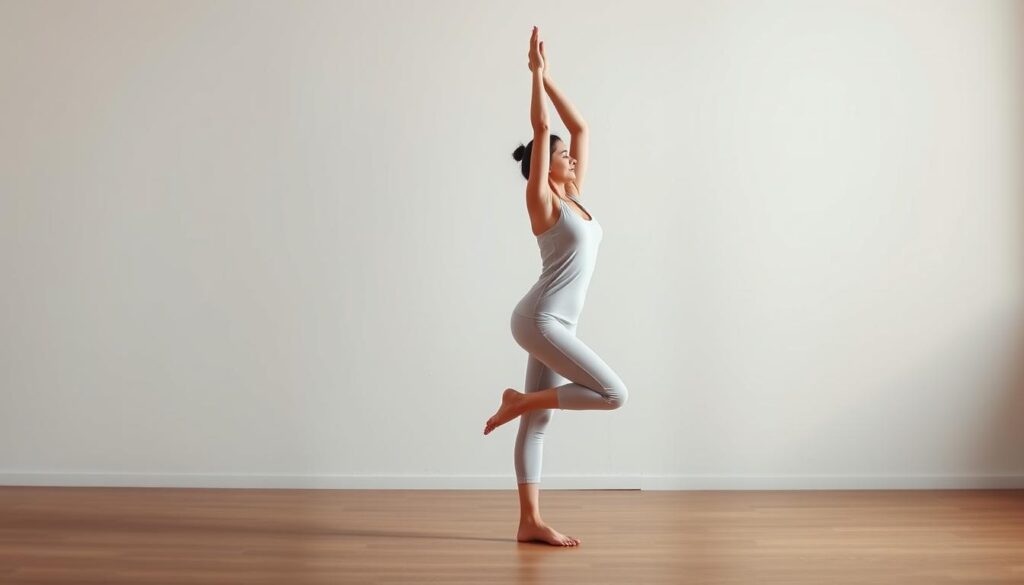
Yoga texts see vrksasana as a pose for patience and inner calm. It connects physical balance with mental clarity. This connection is key to the pose’s transformative power.
The Philosophy of Standing Like a Tree
The philosophy of Tree Pose is deep and spiritual. Trees balance reaching for the sky with deep roots. This balance is the heart of the yogic journey.
“Be like a tree: stay grounded, connect with your roots, turn over a new leaf, bend before you break, enjoy your unique natural beauty, keep growing.”
Trees teach us to be strong yet flexible. They show us to stand firm in our values while bending with life’s changes. This philosophy turns the pose into a meditation on resilience and growth.
The tree’s cycles of growth, rest, and renewal mirror our lives. Practicing vrksasana connects us to these natural rhythms. It teaches us to find stability in change and peace in challenges.
Tree Pose as a Standing Balance Posture
Tree Pose is a key standing balance posture in hatha yoga. It challenges us to find our center while staying graceful. Regular practice improves both physical and mental balance.
This balance pose is unique because it requires single-leg stability. The supporting leg must engage fully, while the lifted leg finds its place. This strengthens the entire body.
| Aspect | Physical Benefits | Mental Benefits | Spiritual Benefits |
|---|---|---|---|
| Balance | Improves proprioception | Enhances focus | Cultivates inner stability |
| Strength | Builds leg muscles | Develops concentration | Strengthens resolve |
| Flexibility | Opens hips and ankles | Increases patience | Promotes adaptability |
| Posture | Aligns spine | Calms mind | Connects to nature |
Standing yoga poses like Tree Pose are foundational. They teach us to find strength and balance in upright positions. The standing balance element adds a challenge that promotes growth and self-awareness.
Regular practice of the Tree Pose develops skills for more advanced poses. It’s both a preparatory pose and a complete practice. Its simplicity allows us to focus on balance and breath.
Step-by-Step Instructions to Practice Tree Pose
Learning Tree Pose starts with knowing the basics. These basics help you stand steady and move gracefully. Each step builds on the last, helping your body learn naturally.
Being patient and paying attention to details is key. Don’t rush. Take your time to get each part right before moving on.
Beginning in Mountain Pose (Tadasana)
Tree Pose begins with a strong base in Mountain Pose or Tadasana. This stance helps you feel grounded and ready for balance. Stand with your feet hip-width apart, evenly distributing your weight.
Engage your leg muscles and keep your spine straight. Imagine your head reaching up and your feet digging into the ground. This mix of grounding and lifting is essential for Tree Pose.
Take deep breaths in Tadasana to center yourself. Release any tension you feel. This step is vital for balancing well.
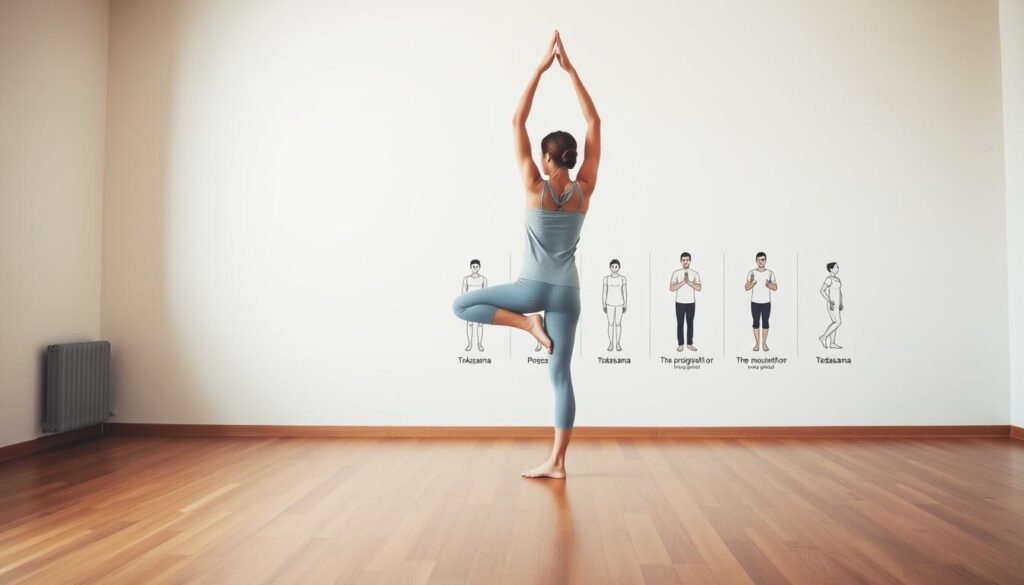
Proper Foot Placement on the Inner Thigh
Shift your weight onto your left foot, feeling it press into the ground. Lift your right foot slowly, keeping control. Your standing leg should stay strong and stable.
Place your foot on the inner thigh of your standing leg, avoiding the knee. Your foot should be above or below the knee, not on the side. Press your foot into your leg as your leg presses back, creating a stable connection.
If placing your foot on the inner thigh is hard, try the inner calf or ankle. Keep your toes on the ground for extra support if needed. Aim for a position that supports stability and builds strength.
| Foot Placement Option | Difficulty Level | Key Benefits | Safety Notes |
|---|---|---|---|
| Toes on ground, heel on ankle | Beginner | Maximum stability, confidence-building | Keep most weight on the standing leg |
| Foot on inner calf | Intermediate | Improved balance, core engagement | Avoid pressing into the knee area |
| Foot on inner thigh | Advanced | Full hip opening, maximum challenge | Press firmly, avoid the knee joint |
| Foot off the ground variations | Expert | Complete balance mastery | Requires significant practice |
Hand Positions from Prayer Position to Full Expression
Start with hands in prayer position at the heart, known as Anjali Mudra. This position is a good starting point for balance. Press your palms together firmly to focus your energy.
Once balanced, you can raise your arms overhead. Extend your arms straight up, keeping them parallel or bringing palms together above your head. This increases the challenge by raising your center of gravity.
Advanced practitioners might try swaying like branches in the wind. But beginners should first master the basic prayer position. Your arms should always support your balance, not hinder it.
Maintaining Balance and Breath Awareness
Controlled breath is key to staying balanced in Tree Pose. Breathe steadily and evenly, avoiding tension. Deep, rhythmic breathing calms your nervous system and helps with balance.
Focus on a point at eye level to keep your balance. This technique, called drishti in yoga, provides visual stability. Avoid looking down or around, as this can make you unstable.
Hold the pose for 30 seconds to one minute, based on your comfort. Quality is more important than how long you hold it. Slowly lower your foot back to the ground and return to Mountain Pose when you’re ready.
Practice Tree Pose on both sides for balanced development. Start with your stronger side to build confidence, then try the more challenging side. This ensures even development and prevents muscle imbalances.
Benefits of Tree Pose for Balance and Overall Health
The benefits of tree pose are vast, touching both physical strength and mental clarity. This standing posture makes positive changes in the whole body. Regular practice brings improvements that last beyond the yoga mat.
Tree pose is a powerful tool for wellness. It strengthens weak areas and boosts coordination. It also improves focus and confidence in tough situations.
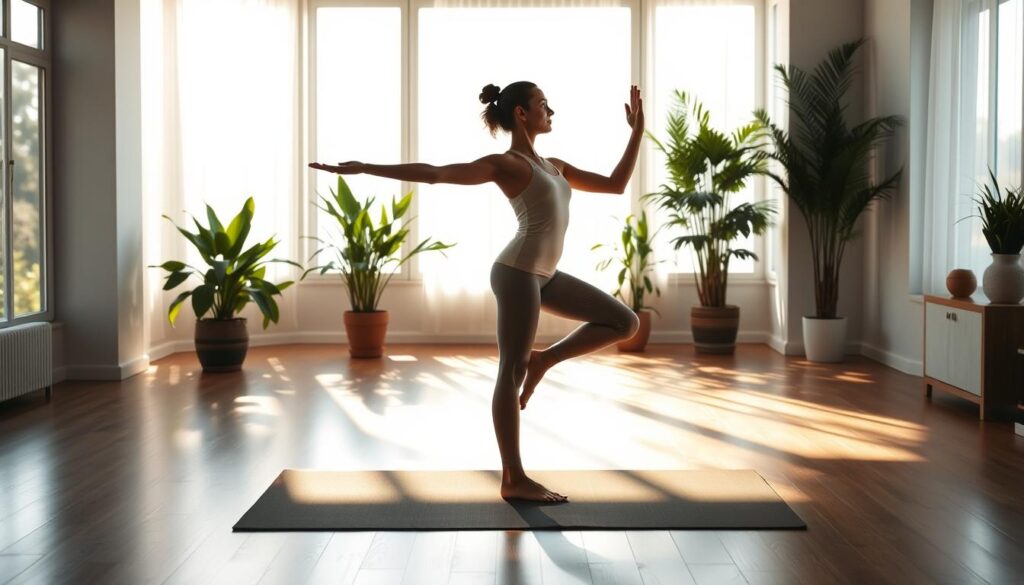
Physical Benefits for Core Muscles and Standing Leg
The physical benefits of Vrksasana are clear and measurable. Core muscles work hard to keep balance. They prevent swaying and falling.
The standing leg gets incredibly strong from holding weight. Muscles from the foot to the hip work together. This builds endurance and better body awareness.
Small muscles around the ankle get stronger with practice. These muscles are key to balance. They help in walking, running, and more.
Tree pose benefits also improve muscle coordination. The pose requires muscles to work together. This leads to better sports performance and less injury risk.
Improved Posture and Spinal Alignment
Regular practice improves posture and alignment in the spine. The pose helps maintain natural curves and strengthens muscles. This counters the effects of sitting too long and poor posture.
The spine learns to stay aligned against gravity. Deep back muscles get stronger. This reduces strain on the spine.
Shoulders and head alignment also improve. This reduces neck tension and headaches from forward head posture.
Long-term practice makes better posture automatic. This reduces energy spent on daily activities.
Mental Benefits for Focus and Mind-Body Connection
The mental benefits of Tree Pose are just as impressive. The pose requires focus to maintain balance in the body. This quietens the mind and promotes being present.
Practicing this pose challenges your balance and builds mental toughness. Each wobble is a chance to practice patience and persistence. These qualities improve in daily life.
Regular practice strengthens the body and mind connection. Practitioners become more aware of body changes. This improves reaction times and prevents falls.
Tree Pose is like a moving meditation that calms the nervous system. The need for proper alignment and balance creates focus. This mental training reduces stress and improves emotional control.
Tree Pose Modifications and Variations for All Levels
Tree Pose is great because it can be changed to fit many levels. It has many modifications and variations for different abilities and experiences. This helps everyone find their own way to practice this balancing pose.
It’s important to listen to your body and go slow when making changes. Each variation helps build strength, balance, and confidence. The goal is to find a challenge that helps you grow without risking safety or proper form.
Beginner Modifications Using Wall Support
Beginners often use a wall or chair for extra stability. Standing with your back against a wall helps you balance better. It lets you focus on foot placement without worrying about falling.
If placing your foot on your thigh is hard, try it on your ankle or calf. This avoids knee pressure. These changes keep the pose’s essence while building confidence.
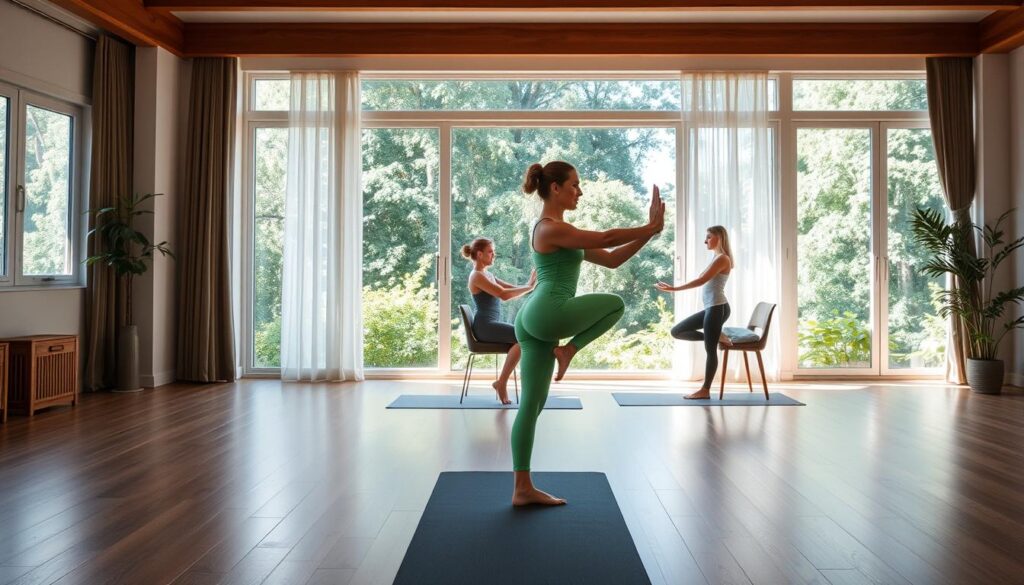
Chair support is another great option for balance challenges. Lightly touching a chair back with one hand helps. It lets you build core strength while getting used to balancing.
- Start with both hands on the wall, then progress to one hand
- Use a chair for light fingertip support rather than gripping tightly
- Practice near a wall, even when not touching it, for psychological comfort
- Focus on engaging the standing leg muscles to build strength
Advanced Variations and Challenges
Advanced yoga practitioners can try many challenging tree pose variations. The revolved tree pose adds a twist by bringing the opposite elbow to the raised knee. This challenges the core muscles a lot.
Closing your eyes in Tree Pose makes it much harder. It forces you to rely on your body’s sense of balance. Start with short periods of closed eyes before trying longer holds.
Arm movements add more challenges for experienced yogis. Moving your arms while balancing tests your stability and control. Try reaching your arms overhead, extending them to the sides, or making flowing movements.
- Practice revolved tree pose by twisting toward the standing leg
- Add arm movements like eagle arms or prayer twists
- Challenge balance by closing eyes for 10-30 seconds
- Attempt the pose on unstable surfaces like a yoga block
- Flow between different arm positions while holding the pose
Preparatory and Follow-up Poses in Your Yoga Sequence
Preparatory poses warm up the body for Tree Pose. Standing poses like Warrior II and Triangle Pose strengthen the legs and improve balance. These poses prepare you for single-leg stands.
Mountain Pose is a great starting point. It teaches proper alignment and grounding. Hip-opening poses like Bound Angle Pose make foot placement easier. Calf raises and ankle circles prepare the standing leg for balance.
Follow-up poses help us use the benefits of Tree Pose. Forward bends like the Standing Forward Bend relax the legs and calm the mind. Seated poses offer a gentle transition and keep the sense of balance.
When adding Tree Pose to a yoga sequence, think about the flow and demands. Place it early when energy is high and focus is sharp. Balancing poses work best when the body is warm but not tired.
- Preparatory poses: Mountain Pose, Warrior II, Triangle Pose, calf raises
- Complementary balancing poses: Dancer’s Pose, Eagle Pose, Standing Figure Four
- Follow-up poses: Standing Forward Bend, Seated Spinal Twist, Child’s Pose
- Integration poses: Savasana, meditation, gentle hip openers
Tree pose variations offer endless growth and exploration. Whether starting with wall support or trying advanced poses, everyone can find their level. Remember, yoga progress comes from consistent practice and patience, not rushing into poses.
Conclusion
Tree pose is more than just a balance exercise. It’s a key part of yoga that helps you grow in many ways. It’s important for all levels of students, from beginners to experts.
Practicing the tree pose regularly brings big benefits. You’ll get better at staying stable and focusing your mind. This makes your yoga practice even stronger.
Having a certified yoga teacher is very helpful. They guide you safely through the tree pose. They teach you to stay balanced and keep your shoulders relaxed.
Tree pose is easy to do anywhere, anytime. You don’t need any special gear. It’s great for practicing at home or in a class.
It’s a great way to build strength and improve your posture. Even experienced yogis can learn from it. Tree pose teaches us to find balance in all situations.
Tree pose is a stepping stone to more challenging poses. It also helps right away with your posture and focus. It’s a timeless practice that changes lives by teaching us about balance and grace.
